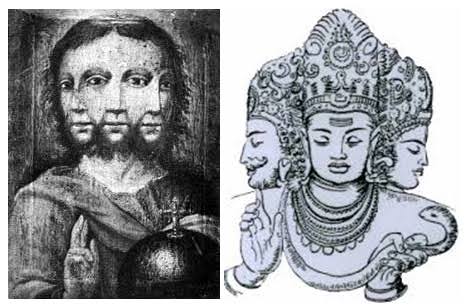Most Christendom believes in what they called Trinity. In this kind of doctrine, they thought that God Almighty is a part of “threefold persons”. Is this doctrine biblical?
Definition of Trinity
The Roman Catholic Church and other Christian denominations taught that God is a Trinity. What is this doctrine of Trinity? The Cathecism of Catholic Church defines the doctrine of Trinity, saying:
“The Trinity is the term employed to signify the central doctrine of the Christian religion — the truth that in the unity of the Godhead there are Three Persons, the Father, the Son, and the Holy Spirit, these Three Persons being truly distinct one from another.”
According to that, “God” is said to have “three persons” – God the Father, God the Son, and God the Holy Spirit – those three are said to be “truly distinct from each other.”
Therefore, the “three persons” are “different” to the fellow person! That is, according to the supporters of the Trinity, “the Father is different from the Son and the Son is different from the Holy Spirit.” If so, how could it be “one God” if the three persons turned out to be “different” from each other?
It would appear that the true meaning of the Trinity is no different from “Tritheism” – the belief in “three different gods”.
Origins of the Doctrine of Trinity
Many scholars admit that the doctrine and concept of the Trinity doctrine dates back before the birth of Christ. There were also many nations around Israel in ancient times that worshiped “multiple gods” or the so -called polytheism.
Here are some evidence that proves the paganistic origin of the Trinitarian doctrine according to some scholarly resources:
“The impression could arise that the Trinitarian dogma is in the last analysis a late 4th-century invention. In a sense, this is true . . . The formulation ‘one God in three Persons’ was not solidly established, certainly not fully assimilated into Christian life and its profession of faith, prior to the end of the 4th century.”—New Catholic Encyclopedia (1967), Volume 14, page 299.
“The Council of Nicaea met on May 20, 325 [C.E.]. Constantine himself presided, actively guiding the discussions, and personally proposed . . . the crucial formula expressing the relation of Christ to God in the creed issued by the council, ‘of one substance with the Father.’ . . . Overawed by the emperor, the bishops, with two exceptions only, signed the creed, many of them much against their inclination.”—Encyclopædia Britannica (1970), Volume 6, page 386.
Marie Sinclair, Countess of Caithness, in her 1876 book Old Truths in a New Light, states: “It is generally, although erroneously, supposed that the doctrine of the Trinity is of Christian origin. Nearly every nation of antiquity possessed a similar doctrine. [The early Catholic theologian] St. Jerome testifies unequivocally, ‘All the ancient nations believed in the Trinity'” (p. 382).
Notice also how the following quotes document belief in a divine Trinity in many regions and religions of the ancient world:
Sumerian Trinity
“The universe was divided into three regions each of which became the domain of a god. Anu’s share was the sky. The earth was given to Enlil. Ea became the ruler of the waters. Together they constituted the triad of the Great Gods” (The Larousse Encyclopedia of Mythology, 1994, pp. 54-55)
Babylonian Trinity
“The ancient Babylonians recognised the doctrine of a trinity, or three persons in one god—as appears from a composite god with three heads forming part of their mythology, and the use of the equilateral triangle, also, as an emblem of such trinity in unity” (Thomas Dennis Rock, The Mystical Woman and the Cities of the Nations, 1867, pp. 22-23).
Indian Trinity
“The Puranas, one of the Hindoo Bibles of more than 3,000 years ago, contain the following passage: ‘O ye three Lords! know that I recognize only one God. Inform me, therefore, which of you is the true divinity, that I may address to him alone my adorations.’ The three gods, Brahma, Vishnu, and Siva [or Shiva], becoming manifest to him, replied, ‘Learn, O devotee, that there is no real distinction between us. What to you appears such is only the semblance. The single being appears under three forms by the acts of creation, preservation, and destruction, but he is one.’
“Hence the triangle was adopted by all the ancient nations as a symbol of the Deity . . . Three was considered among all the pagan nations as the chief of the mystical numbers, because, as Aristotle remarks, it contains within itself a beginning, a middle, and an end. Hence we find it designating some of the attributes of almost all the pagan gods” (Sinclair, pp. 382-383).
Greek Trinity
“In the Fourth Century B.C. Aristotle wrote: ‘All things are three, and thrice is all: and let us use this number in the worship of the gods; for, as the Pythagoreans say, everything and all things are bounded by threes, for the end, the middle and the beginning have this number in everything, and these compose the number of the Trinity'” (Arthur Weigall, Paganism in Our Christianity, 1928, pp. 197-198).
Egyptian Trinity
“The Hymn to Amun decreed that ‘No god came into being before him (Amun)’ and that ‘All gods are three: Amun, Re and Ptah, and there is no second to them. Hidden is his name as Amon, he is Re in face, and his body is Ptah.’ . . . This is a statement of trinity, the three chief gods of Egypt subsumed into one of them, Amon. Clearly, the concept of organic unity within plurality got an extraordinary boost with this formulation. Theologically, in a crude form it came strikingly close to the later Christian form of plural Trinitarian monotheism” (Simson Najovits, Egypt, Trunk of the Tree, Vol. 2, 2004, pp. 83-84).
Other regional areas around the world has their own different versions of Trinitarian gods.
“The ancient heathen deities of the pagan Irish[,] Criosan, Biosena, and Seeva, or Sheeva, are doubtless the Creeshna [Krishna], Veeshnu [Vishnu], [or the all-inclusive] Brahma, and Seeva [Shiva], of the Hindoos” (Thomas Maurice, The History of Hindostan, Vol. 2, 1798, p. 171).
Aside from being a pagan source, the Church adopted this pagan Trinitarian teaching. Also, the Trinitarian dogma is a late fourth-century invention. Here are some proofs:
Encyclopædia Britannica states: “Neither the word Trinity nor the explicit doctrine appears in the New Testament . . . The doctrine developed gradually over several centuries and through many controversies.”
“The doctrine of the trinity . . . is not a product of the earliest Christian period, and we do not find it carefully expressed before the end of the second century.”—Library of Early Christianity—Gods and the One God.
Egyptologist Arthur Weigall, while himself a Trinitarian, summed up the influence of ancient beliefs on the adoption of the Trinity doctrine by the Catholic Church in the following excerpt from his previously cited book:
“It must not be forgotten that Jesus Christ never mentioned such a phenomenon [the Trinity], and nowhere in the New Testament does the word ‘Trinity’ appear. The idea was only adopted by the Church three hundred years after the death of our Lord; and the origin of the conception is entirely pagan . . . (pp. 197-203).
Bible Answered!
There are many passages in the Bible that refute the doctrine of the Trinity. According to Trinitarians, “God the Father, God the Son, and God the Holy Spirit are equal or equal levels of strength, nature, and power.” However, this is contrary to what the Bible writes and teaches! How?
1. When Jesus was on earth, he said that “the Father is greater [in power, nature, and might] than I am.” – John 14:28
2. When Jesus was resurrected, he told Mary Magdalene, that he had “my Father, and your Father, my God and your God.” – John 20:17
3. The Bible says, that even when Jesus was in heaven, he was still submissive to his Father God who gave him the power to be “Lord and Christ”. – Matthew 28:18; John 3:35; Acts 2:36
4. Even the Holy Spirit is “commanded”, just as Christ is commanded by God who exalts all. – John 14:26; 15:26; 16:13
5. Nor is the Father equal to his Son and the Holy Spirit because the Son and the Holy Spirit or the angels know nothing that only the Father knows. – Matthew 24:36; Mark 13:32; Acts 1: 7
6. When Jesus was in heaven, the apostle Paul wrote that “the head of the Christ is God.” (1 Corinthians 11: 3) Jehovah is the “head” or “supreme” of Christ Jesus. So Trinity is wrong. — 1 Corinthians 15:27; 1 Corinthians 15:28
7. The apostle Paul himself acknowledged that Jesus and the Father were not equal when he wrote that he “did not think to take away, that is, that he [Jesus] might be equal with God.” (Philippians 2: 6) So it refutes the Trinitarians who say that “Jesus is equal to the Father” even though nothing can be read in the Bible.
8. Nor is Christ “God Almighty” because there is no written prophecy in the Old Testament that God Almighty would be the Messiah. This is contrary to what is taught in Isaiah 9: 6 which foretells that the coming Messiah will be called “mighty God”, not “Almighty God”! “Mighty” is different from “Almighty” or “far more powerful than all”, that is only Jehovah the Father. — Genesis 17: 1; Psalm 83:18
9. When Jesus was on earth, he taught that he had a “worshiped” and “acknowledged” God. – John 4:22.
10. Jesus referred to the Father as “the only true God” Almighty! (John 17: 3) The apostle Paul made the same statement when he said “to us there is one God the Father, of whom are all things, and we to him;” – 1 Corinthians 8: 6
11. The Bible always mentions that the “holy spirit” is “poured out” or “anointed” on the servants of Christ so that they are all “filled” with the holy spirit. (Acts 2: 4; 6; 3; 1 Peter 1:12) This does not prove that the holy spirit is a person. Rather, it implies God’s “power” or “force” to do what he wills.
12. The “holy spirit” is also called the “spirit of truth” and “the spirit of holiness.” (John 14:17; 16:13; Romans 1: 4) This power or spirit of God begets, anoints, those who are members of the body of Christ. (John 3: 5-8; 2 Corinthians 1:21, 22) It also gives strength, and it leads God’s people today. – Gal 5:16, 18
The Bible is a “monotheistic book”. The Jews did not believe in the Trinity even though Jesus himself was also a Jew.
If you open your mind, you are convinced that the “one God” of the Bible is not part of three persons, rather, he is only “one”-the God and Father of our Lord Jesus Christ and our Father. – Isaiah 63:16; 64: 8; Matthew 6: 9; Luke 11: 1; Hebrews 2:11
Latest Posts
- China dams release water, submerging more cities and flooding more streets |
- Terror attack in Dagestan, Russia kills police, priest and destroyed churches and synagogues |
- Why is Jesus an “Archangel”, not God Almighty himself? |
- Terrorist weapon supplier killed in Lebanon strike, Israel reports |
- PH vloggers Rosmar Tan and Rendon Labador declared ‘persona non grata’ in Palawan |

